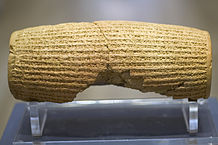… there was the idea, rather than the word. Humans need to have an idea or understanding of something – a beast, a geographical feature – to appreciate it cognitively in some way, before we name it. But the word and words come soon after. Language develops according to need. Vocabulary increases as cognition (and socialisation) increases or as new things arise or are invented. You are reading a blog on a PC or laptop, using the internet – the on-line world generates neologisms by the bucket load, take a look, or have a listen, at Thoughtcast.
But when did we, Homo sapiens sapiens, start to write things down?
 Possibly as early as 7,000 years BCE. Examples of proto-writing, of a series of symbols resembling writing, have been found in Jaihu in northern China which radio-carbon dating places at about 9,000 years old (see left). These neolithic symbols are but a step or two beyond the pictures we find in early cave paintings and drawings, usually representations of the natural world. Through the 6th and 5th millenia BCE such symbols grew more sophisticated, culminating in symbols like those found on the Tartaria tablets in modern-day Romania, dating 5,300 BCE. The earliest hieroglyphic scripts, of Egypt, Sumerian proto-cuneiform and Cretan, grew from such symbols.
Possibly as early as 7,000 years BCE. Examples of proto-writing, of a series of symbols resembling writing, have been found in Jaihu in northern China which radio-carbon dating places at about 9,000 years old (see left). These neolithic symbols are but a step or two beyond the pictures we find in early cave paintings and drawings, usually representations of the natural world. Through the 6th and 5th millenia BCE such symbols grew more sophisticated, culminating in symbols like those found on the Tartaria tablets in modern-day Romania, dating 5,300 BCE. The earliest hieroglyphic scripts, of Egypt, Sumerian proto-cuneiform and Cretan, grew from such symbols.
It was the script from Sumer in Mesopotamia, modern-day Iraq, which developed into the first true system of writing.
The Sumerian language is not an indo-european language, though its geography of origin would suggest it might be. In fact it pre-dates indo-european languages and is unique. The Kish tablet, dated 3500 BCE shows a proto-cuneiform script, a series of marks, incised into the clay, using a stick. By 3100 BCE Sumerian is captured on clay in a series of pictograms written vertically. By the end of the 4th millenium this had evolved into cuneiform. Cuneiform means ‘wedge-shaped’ and is a word derived from Latin, but it describes the way in which the script was  written down, using a wedge-shaped stylus to push symbols into soft clay.
written down, using a wedge-shaped stylus to push symbols into soft clay.
From about 2900 BCE the pictograms become less representational, more a series of recognisable signs. The number of signs reduces to about 600 ( from over 1,000) and are adapted further to denote context. By 2,500 BCE these signs are written left to right and they become more sophisticated, moving further and further away from their origins. The Sumerians used this cuneiform script to keep accounts, draft legal documents and commemorate events.
Sumerian cuneiform was then adopted by the Akkadians, a semitic people from the north, who conquered Sumer. The first Akkadian King to appear in cuneiform is Sargon of Akkad, in about 2330 BCE. Sumerian and its script is absorbed into what becomes Assyrian and Babylonian, the latter having a greater phonetic component. This lasts as a daily spoken and literary language until the Iron Age (10th to the 6th centuries BCE) when the Assyrian language is superceded by Phoenician and Aramaic, with their associated alphabets. The Greek and subsequent alphabets, including Latin, are derived from the Phoenician alphabet and the Arabic and Hebrew alphabets are derived from the Aramaic alphabet. Which brings us broadly up to date.
The British Museum, where I recently attended a talk on early writing, has a very large collection of examples of cuneiform, which demonstrate its  development. One of the later ones is the Cylinder of Cyrus, right, which was written following the Persian conquest of Babylon in 539 BCE by King Cyrus, or Cyrus the Great, the subject of writings by Herodotus and Xenophon. This, it has been claimed, is the earliest charter of human rights, a claim which is disputed. But it does represent a written record of how to try to run a society which includes different nationalities and faiths. Humans were trying to puzzle this out in Persia at roughly the same time as democracy developed in ancient Athens.
development. One of the later ones is the Cylinder of Cyrus, right, which was written following the Persian conquest of Babylon in 539 BCE by King Cyrus, or Cyrus the Great, the subject of writings by Herodotus and Xenophon. This, it has been claimed, is the earliest charter of human rights, a claim which is disputed. But it does represent a written record of how to try to run a society which includes different nationalities and faiths. Humans were trying to puzzle this out in Persia at roughly the same time as democracy developed in ancient Athens.
And the rest of the world? Proto-writing has been found in several places. It developed, independently, across the globe, though transition to a full system of writing happened at different times in different locations.
In Europe, with the exception of Linear A (Cretan script), the Phoenician script is the first writing system used (in the Iron Age) although there are symbols used earlier by the Beaker people (Bronze Age) which may represent numerals. Chinese script emerges between 14th and 11th century BCE (Chinese Bronze Age). There are examples of Indus symbols, from the Indus Valley, dated to between 3500 and 1900 BCE but there is no agreed, known language associated with them and this is not accepted as a true system of writing. Indian writing systems are later (Indian Iron Age). In Africa Nsibidi symbols have been found in south-western Nigeria and are accepted as a form of early writing, as it was used to send messages. Use dates back before 500 BCE (African Iron Age).
In writing, as in agriculture and urbanisation, the Fertile Crescent between the Tigris and the Euphrates did it first.
Apologies to those eminent writers on language development and writing whom I studied so many years ago. And many thanks to the wonderful treasure trove which is the British Museum.
If you enjoyed reading this article you might also like The First Library From Gutenberg to Google Galleys & Ornaments


 RSS – Posts
RSS – Posts